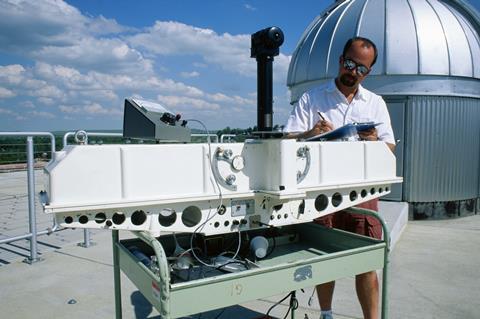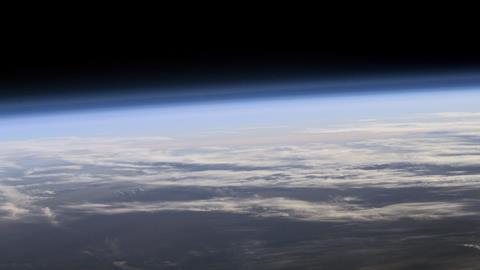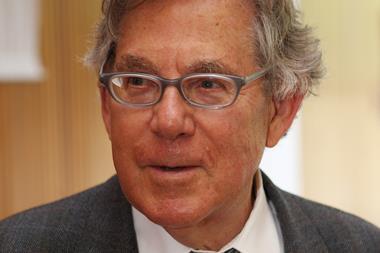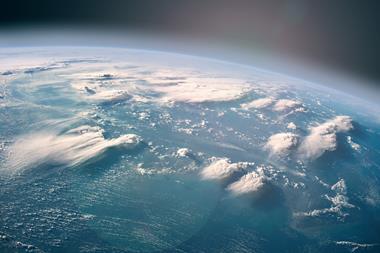Just over 30 years ago, scientists discovered an environmental crisis so terrifying it shocked the world into action. The image of the ozone hole over Antarctica – a widening rip in the very fabric of Earth’s sun-shielding stratosphere – was a symbol of destruction so obvious even politicians couldn’t ignore it.
Policies were quickly put in place to ban the offending chemicals, and so began the long, slow process of fixing the damage. In the decades since, ozone has taken a backseat in the minds of the public as fresh crises have arisen. Today we’re more likely to hear about the perils of climate change, microplastics and urban smog.
The chemical measurements showed that chlorine was definitely the cause of the ozone hole
But the hole remains, and there are signs that ozone depletion cannot yet be ticked off Earth’s environmental watch list. As governments work themselves into a frenzy about the polluted air in cities or the scourge of plastic waste in the sea, there is growing evidence they should not be ignoring the situation above the clouds.
Detection and decline
Susan Solomon remembers how the ozone hole’s discovery in the 1980s shocked the entire world. She was part of a group within the US National Oceanic and Atmospheric Administration (NOAA) who travelled to Antarctica to measure the formation of chlorine monoxide (ClO) free radicals in the region where ozone destruction was most dramatic. Her observations helped prove the theory proposed more than a decade earlier by Mario Molina that ozone was being broken down on a catastrophically large scale by free radicals of chlorine and ClO, which were in turn being generated by the action of UV light on chlorofluorocarbons (CFCs) emitted by human activities. This happens more rapidly in Antarctica because the icy clouds in the stratosphere attract CFC molecules and provide a surface for the reactions to take place on.
‘The chemical constituent measurements showed that chlorine was definitely the cause of the ozone hole,’ says Solomon, who is now based at the Massachusetts Institute of Technology in the US. ‘When you see a great big effect like that you don’t have to start debating statistics. The scientists could make their case very clear and strong, and the politicians had no choice but to go ahead and do what was obvious.’
Work from Solomon and others showed unequivocally that widely used chemicals were stripping the planet of its sun protection and was the catalyst for one of the most successful international environmental agreements ever put into action. The Montreal Protocol on Substances that Deplete the Ozone Layer committed signatories to phasing out halogenated compounds that damage ozone – including CFCs, hydrochlorofluorocarbons and bromine-containing hydrocarbons – in order to bring down atmospheric levels of chlorine and bromine and mitigate further ozone depletion. First agreed in 1987, it has since been ratified by 196 states and the European Union, making it the first treaty in United Nations history to be universally adopted.
And so far, it appears to be working. Stephen Montzka, who works at NOAA’s earth systems research laboratory in Boulder, US, has seen the effects of the Montreal Protocol first-hand. His job is to keep an eye on global changes in the atmospheric concentration of dozens of ozone-depleting chemicals, using state-of-the-art instrumentation to analyse air samples from around the world.
‘We send flasks to various locations, they turn on a pump and capture some of the air. The container is shipped back to us in Boulder where we analyse it with instrumentation we’ve customised,’ Montzka says. ‘For over 25 years I’ve been receiving flasks from around the world at my lab, reporting concentrations of these different trace gases over time.’
Montzka monitors levels of around 40 chemicals including major chlorine- and bromine-containing ozone-depleting substances that have been controlled or banned by the Montreal Protocol, but can persist in the atmosphere for many years. In the mid-1990s his lab announced that the total amount of chlorine and bromine in the atmosphere had peaked and was starting to decline.1
‘That was the first turnaround – the first noting that the concentrations of these chemicals that cause ozone depletion were no longer going up. That was a nice milestone to be able to document,’ he says.
Since hitting their peak these chemicals have been steadily declining, while levels of the more ozone-friendly hydrochlorofluorocarbons brought in to replace them have in turn gone up, an indication that the Montreal Protocol is working as intended.
Road to recovery
But while it is plain to see that the atmospheric abundance of chlorine and bromine has declined significantly in recent years, it is hard to quantify the benefits of these declines on actual ozone levels in the stratosphere, says Ryan Hossaini, who models long-term changes in the chemistry and composition of Earth’s atmosphere at Lancaster University in the UK.
‘Although satellite measurements of ozone began in the late 1970s, isolating a clear signal of ozone layer recovery, attributable solely to declines in chlorine and bromine, is tricky,’ he says. ‘This is largely due to variability introduced by several other factors that influence ozone, including stratospheric dynamics, stratospheric aerosol and solar irradiance, among others.’

There are several ways to measure ozone. Light measurements are taken at various locations on the ground – including the Halley and Rothera research stations in Antarctica – using a Dobson spectrophotometer, which measures the intensity of wavelengths of light that are absorbed by ozone, and uses this to work out the overall thickness of ozone at a particular location. Satellites are used to monitor ozone from space using a similar method, but measuring light reflected off the surface of the Earth at wavelengths absorbed by ozone.
Instruments called ozonesondes provide a more detailed depth profile of ozone and can be launched virtually anywhere in the world, carried up through the different layers of the atmosphere by weather balloons. Their sensors contain a source of potassium iodide, which reacts with ozone and generates an electrical signal proportional to the amount of ozone present that can be beamed down to a receiver on the surface.

But while there is a lot of data available – much of it real-time – assessing the overall health of the ozone layer over long timescales isn’t always straightforward. The distribution of ozone is not uniform, and varies seasonally in different parts of the stratosphere. The hole over Antarctica, for example, opens up during the Southern Hemisphere spring so the time of year at which it is measured matters.
Hossaini adds that climate change is also confounding the way recovery is monitored because it is causing changes to both the physical structure of the stratosphere and its chemistry, making it unrealistic to expect the ozone layer to ever return to its pre-depletion state.
Yet there is some clear evidence that the Montreal Protocol is doing its job. In 2016 Solomon and her colleagues reported signs that the Antarctic hole had shrunk by 4 million km2 since 2000, although fluctuations due to volcanic eruptions emitting ozone-depleting gases such as sulfur dioxide have complicated the picture.2
‘We showed [recovery] with both area and depth of the ozone hole. The fingerprints of healing are very clear and they match what we would expect based on the amount by which chlorine has decreased relative to its peak value by now,’ says Solomon. ‘Lots of different people have looked at it in lots of different ways and the bottom line is really quite robust – the Antarctic is recovering.’
Others have calculated that without the Montreal Protocol’s action global ozone depletion would have been substantially worse and ozone loss over the Northern Hemisphere would have become much more severe, potentially causing a similar ozone hole over the Arctic.3
Unexpected emissions
While these are undoubtedly reasons to celebrate, there are still challenges ahead. Using information from past trends, scientists have come up with predictions for when stratospheric ozone will be restored to pre-1980 levels – a benchmark that is commonly used for recovery. The latest mathematical models put the date for global ozone returning to this level around the middle of the century. Levels over Antarctica will follow around a decade later.4
But this relies on the continued decline of chlorine and bromine in the atmosphere. Earlier this year, Montzka and co observed that levels of an important ozone-depleting chemical – trichlorofluoromethane, or CFC-11 – weren’t going down as fast as expected.5

Measurements taken at the Mauna Loa Observatory in Hawaii indicated that from 2012 onwards the decline in CFC-11 has been 50% slower than expected. Models suggested that emissions must have been increasing by 25% per year since 2012 to account for these observations, which couldn’t all be explained by releases from CFC ‘banks’ that persist in old equipment and products.
‘That was a puzzle. It was hard to imagine that that would happen without something unusual happening. And we spent some time investigating what the likely cause was,’ says Montzka. He and his colleagues concluded that the source of emissions was likely to be new production of CFC-11 – something which has been banned since 2010. Modelling the movements of air masses reaching the site where samples were collected suggested the source was somewhere in east Asia.
An organisation called the Environmental Investigation agency (EIA) has since uncovered evidence that CFC-11 is being illegally produced in China, where it is used as a foam blowing agent to make polyurethane insulation. EIA investigators posing as buyers found several companies that claimed to be using CFC-11 because it costs less and makes more effective foam than legal alternatives.
Illegal CFC production wasn’t thought to be amounting to much
‘What we found was not a few individual instances of illegal use but a widespread and persistent use of CFC-11 and indication of large-scale CFC-11 production,’ says Sophie Geoghegan, a campaigner from EIA. ‘Nothing on this scale was expected.’ She tells Chemistry World that several foam manufacturing companies indicated the majority of their production – ranging from 70–100% – used CFC-11, and that some claimed to export polyols containing CFC-11, which were unlikely to be checked at customs.
‘If true, and given the volume of export in polyols from China, all parties to the Montreal Protocol need to examine their imports and tighten customs checks,’ Geohegan says. ‘This issue requires intelligence-led enforcement leading to a clampdown on illegal use and production of CFC-11 alongside policy reform to address the drivers of the trade.’ She adds that China has told EIA they have already begun taking action to look into the information they uncovered.
Montzka says this discovery shows how atmospheric monitoring can allow any issues to be flagged to the relevant authorities. ‘[Illegal CFC production] was thought to be something that wasn’t amounting to much. But looking at the global atmosphere you can see that actually something is amounting to a significant amount,’ he says.
He adds that if these newly uncovered CFC-11 emissions continue at the current rate it could set back the recovery of the ozone layer by about a decade. However, if the problem is dealt with swiftly it is unlikely to have much of an effect. He thinks that although the EIA’s investigation is valuable, their findings should be treated cautiously.
‘It’s not clear how much of that activity accounts for what we see throughout the global atmosphere. The last thing we want is for us five years down the road to have taken care of some particular activities that that report points to and not have the problem be solved,’ he says. Geohegan agrees that it is ‘absolutely possible’ that there are additional sources of CFC-11 production yet to be discovered.
Other threats
Substances not controlled by the Montreal Protocol are another potential threat. Hossaini recently used data collected by Montzka’s lab to show that levels of dichloromethane (DCM) – an industrial solvent used for cleaning or as a feedstock for fine chemicals – were increasing. DCM is much shorter-lived than CFCs and poses a far smaller threat, but it also breaks down ozone and could potentially delay ozone recovery if emissions increase substantially in future.6
‘For a scenario in which dichloromethane remained at present day levels throughout coming decades, the return of Antarctic ozone to pre-1980 levels was delayed by five years. If we assumed dichloromethane growth continued into the future, at the mean rate observed over the 2004–2014 period, then the delay was 30 years,’ says Hossaini. He stresses that the future trajectory of dichloromethane emissions is uncertain.

Montzka says the influence of DCM has so far been small compared to other gases. ‘But if it keeps going up I think it’s something that clearly policymakers are going to probably take a look at more carefully,’ he adds. Results like these highlight the importance of monitoring the global concentrations of DCM and other short-lived gases year on year.
For Solomon, something that poses a more immediate threat are emissions from the ‘bank’ of CFCs that exist locked up in existing sources such as fridges, air conditioners or foam-insulated buildings that were made before the substances were phased out. She points out that even long after new production has stopped completely, bank CFC emissions will continue to supply extremely destructive, long-lived gases to the atmosphere as old items are disposed of or destroyed.
‘The Montreal Protocol controls production – how much is made in a chemical plant – and consumption – how much is sold. It doesn’t control emissions,’ she explains. ‘If it’s in a building that was built before [production was phased out], there are no rules about correct disposal under the MP as it currently stands.’
The issue of how big banks are, and how big their future contribution to emissions could be, is still very much an ‘open question’ that requires research, she adds.
Political success
In spite of various hurdles still to be overcome, there is an overall sense of optimism among scientists that the ozone layer will eventually recover, backed up by strong political will. Parties to the Montreal Protocol meet regularly to discuss arising issues and consider updates to the treaty. The next big meeting is scheduled for November this year, and Montzka was at a working group meeting held ahead of this in July where he was able to share his results.
The scientists had the tools, they used them, the public understood and the industry responded
‘The concern and the interest was just extraordinary,’ he says. ‘That body wants to do everything they can to ensure the ozone layer recovers completely. There’s still potentially work to be done but mechanisms are in place and they are certainly committed and dedicated to allowing that to happen.’
The agreement was designed to be able to respond to unusual occurrences, or ‘bumps and wiggles’ in the recovery, he says. ‘The scientists are continually updating the information and delivering that to the policymakers so that they can respond if necessary.’
While there are currently a few of these bumps and wiggles threatening to delay recovery, the fact that the ozone layer appears to be healing at all is a triumph for all involved. Solomon says that as well as international collaboration this is in large part thanks to a ‘nimble’ chemical industry who were able to generate CFC alternatives. ‘There’s nothing chemists like better than to make something new and better. It’s a very different industrial ethos to someone whose business is extraction,’ she says. That makes it a challenge for anyone hoping to replicate the success of the treaty with other environmental crises – there is no easy replacement for the activities responsible for climate change-causing carbon dioxide emissions, for example.
In time, Solomon believes the story of how we fixed the ozone layer ‘is going to go down in world history as a remarkable environmental success’.
‘The scientists had the tools, they used them, the public understood and the industry responded,’ she says. ‘It feels amazing – we actually did it! I suspect the key question really is: can we do it for other problems? And that’s a hard one to answer.’
References
1 S A Montzka et al, Science, 1996, 272, 1318 (DOI: 10.1126/science.272.5266.1318)
2 S Solomon et al, Science, 2016, 353, 269 DOI: 10.1126/science.aae0061
3 M P Chipperfield et al, Nat. Commun., 2015, 6, 7233 (DOI: 10.1038/ncomms8233)
4 S S Dhomse et al, Atmos. Chem. Phys., 2018, 18, 8409 (DOI: 10.5194/acp-18-8409-2018)
5 S A Montzka et al, Nature, 2018, 557, 413 (DOI: 10.1038/s41586-018-0106-2)
6 R Hossaini et al, Nat. Commun., 2017, 8, 15962 (DOI: 10.1038/ncomms15962)













No comments yet